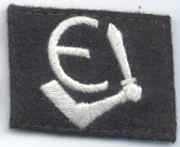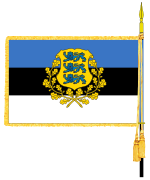20th SS Grenadier Division (1st Estonian)
| 20th Waffen Grenadier Division of the SS (1st Estonian) | |
|---|---|

Divisional insignia of 20th Waffen Grenadier Division of the SS (1st Estonian)
|
|
| Active | 24 January 1944 – 9 May 1945 |
| Country |
|
| Branch |
|
| Type | Infantry |
| Size | Division |
| Part of | III (Germanic) SS Panzer Corps |
| Nickname(s) | Estonian Division |
| Motto(s) | Varemeist tõuseb kättemaks! (Vengeance Will Rise from the Ruins!) |
| Colors | Blue, Black & White |
| March | The Song of Estonian Legionaires |
| Engagements |
Battle of Narva 1944 Battle of Tannenberg Line 1944 Battle of Tartu 1944 Vistula-Oder Offensive 1945 Battle of Oppeln 1945 |
| Commanders | |
| Notable commanders |
Franz Augsberger |
| Insignia | |
| Flag of the division |  |
20th Waffen Grenadier Division of the SS (1st Estonian) (German: 20.Waffen-Grenadier-Division der SS (estnische Nr.1), Estonian: 20. eesti diviis) was a unit of the Waffen SS established on 25 May 1944 in German-occupied Estonia during World War II. Formed in Spring 1944 after the general conscription-mobilization was announced in Estonia on 31 January 1944 by the German occupying authorities, the cadre of the 3rd Estonian SS Volunteer Brigade, renamed the 20th Estonian SS Volunteer Division on 23 January 1944, was returned to Estonia and reformed. Additionally 38,000 men were conscripted in Estonia and other Estonian units that had fought on various fronts in the German Army, and the Finnish Infantry Regiment 200 were rushed to Estonia.
Estonian officers and men in other units that fell under the conscription proclamation and had returned to Estonia had their rank prefix changed from "SS" to "Waffen" (Hauptscharführer would be referred to as a Waffen-Hauptscharführer rather than SS-Hauptscharführer). The wearing of SS runes on the collar was forbidden, and these formations began wearing national insignia instead.
The Division fought the Red Army on the Eastern Front and surrendered in May 1945.
On 16 June 1940, the Soviet Union had invaded Estonia. The military occupation was complete by 21 June 1940 and rendered "official" by a communist coup d'état supported by Soviet troops and the Nazi government under the 23 August 1939 agreement signed in Moscow between Nazi Germany and the Soviet Union as a Treaty of Non-Aggression. A secret protocol of the pact defined domains of influence, with the Soviet Union gaining eastern Poland, Finland, Latvia, Estonia and the Romanian province of Bessarabia. Germany was to control western Poland and Lithuania.
...
Wikipedia
